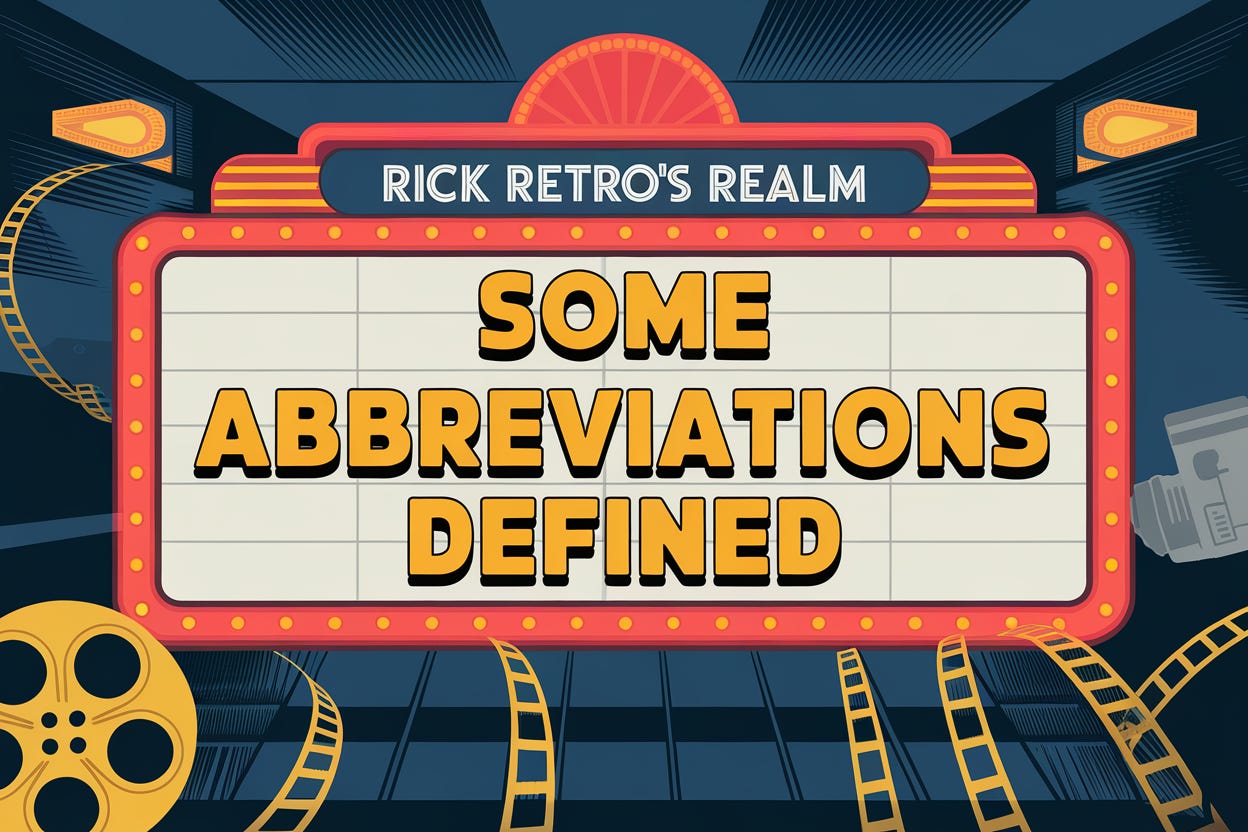Some Abbreviations Defined
Rick Retro's Realm, Behind the Scenes #4: Everything from a cell phone to an 84"-diagonal HD flat screen television with surround sound.
In my reviews I’ve included some abbreviations that I haven’t defined, and now’s as good a time as any to do so.
(Note: This post to the text group was obsoleted and replaced by a Reference Rundown, which you can find here.)
In each review after the Title and media information, I let you know the date I watched (or read or listened to) the reviewed work. If there’s a number in parentheses after the date, that’s the number of times I’ve watched, read or listened to the work in my lifetime. It’s probably an accurate number since around 2000 or so, but just an estimate before that. If there’s no number in parentheses, it’s my first time. 😁
For a movie, you might see brackets instead of parentheses, like this: [#]. That means that even though I almost never go out to the movies anymore, I saw this movie in my younger days in a theater, probably on the biggest screen I could find it on, since that was my thing. 😉
For books that’s followed by a notation as to the format I read.
dS - a small digital screen, probably my phone.
dK - my Kindle device.
dM - a mid-size digital screen, probably a tablet.
dL - a larger digital screen, probably my desktop computer.
dX - an extra-large digital screen. This would be if I read it on my 7-foot diagonal TV for example. I’ve never read something that way before, but I can send my phone video to the TV, so perhaps I will someday!
hb, tpb, or pb means that I read a hardback, trade paperback or standard paperback book.
For videos viewed, the viewing date is followed by 3 notations.
#1 is the picture quality and screen size I most recently watched for the review.
HDX7 - will be the notation for most modern movies and television series. That means I watched in high definition (1080p) on my 7-foot diagonal TV.
HDI7 - an older high definition format that's not quite as detailed (either 1080i or 720p).
sd7 - the old standard definition from 20th century television (520p if I remember right).
3DX7 - means I took advantage of my TV’s 3D to watch a movie in high definition 3D.
UHD7 - would be how I would watch if I replaced my current TV with a 4K TV of the same size. But I don’t want to give up my 3D TV yet... You can’t have both in one TV, at least not that I’m aware of.
#2 refers to the original aspect ratio of the work and the aspect ratio I watched if different.
Modern HD television would normally be the aspect ratio 1.78:1 (I will leave off the :1 part and just use the number that precedes :1) and fills your modern TV screen.
Old TV was shot in 1.33:1 and will have black bars on the sides when watched on a modern TV.
Modern movies are typically shot in 1.85:1 and will usually have a little bit clipped off on the sides when shown on a modern television. I’ll use 1.85v to show the original aspect ratio, but I’m actually watching that in 1.78:1.
If you see a number greater than 1.78, with no v following, I’m watching the original aspect ratio and there are black bars at the top and bottom of the picture so that nothing is cropped.
#3 refers to what I’m hearing. (If I’m listening to a sound recording this will be the only notation.)
0 - a silent film
0D - a silent film with sound added later. The added sound is typically a mono or stereo soundtrack upgraded by modern equipment and played in Dolby Stereo.
1D - originally a mono soundtrack, but I’m listening to a stereo upgrade. When Dolby upgrades mono to stereo it pretty much sends it equally to both speakers of a stereo system or to the center channel of a 5-speaker or 7-speaker surround system like what I've got.
1M - originally a mono soundtrack, but I’m listening to an upgrade to 5-channel surround sound.
2D - Dolby stereo. (Not a 2-dimensional picture as opposed to 3D)
2M - originally a stereo soundtrack, but I’m listening to an upgrade to 5-channel surround sound.
5D - 5-channel Dolby surround sound.
5M - processed sound that is sent directly to each of the 5 main speaker channels. It’s how most of my modern movies stream with Vudu. Lots of Blu-ray discs have it too.
7D and 7M - the same as 5D and 5M but sends some sound to my two rear speakers as well as the 5 speakers normally used in surround setups. Typically only available on discs, not streaming services.
Thanks for your support.
Keep the comments coming!
Originally posted to text group 2024-12-05
Last updated 2025-02-25




